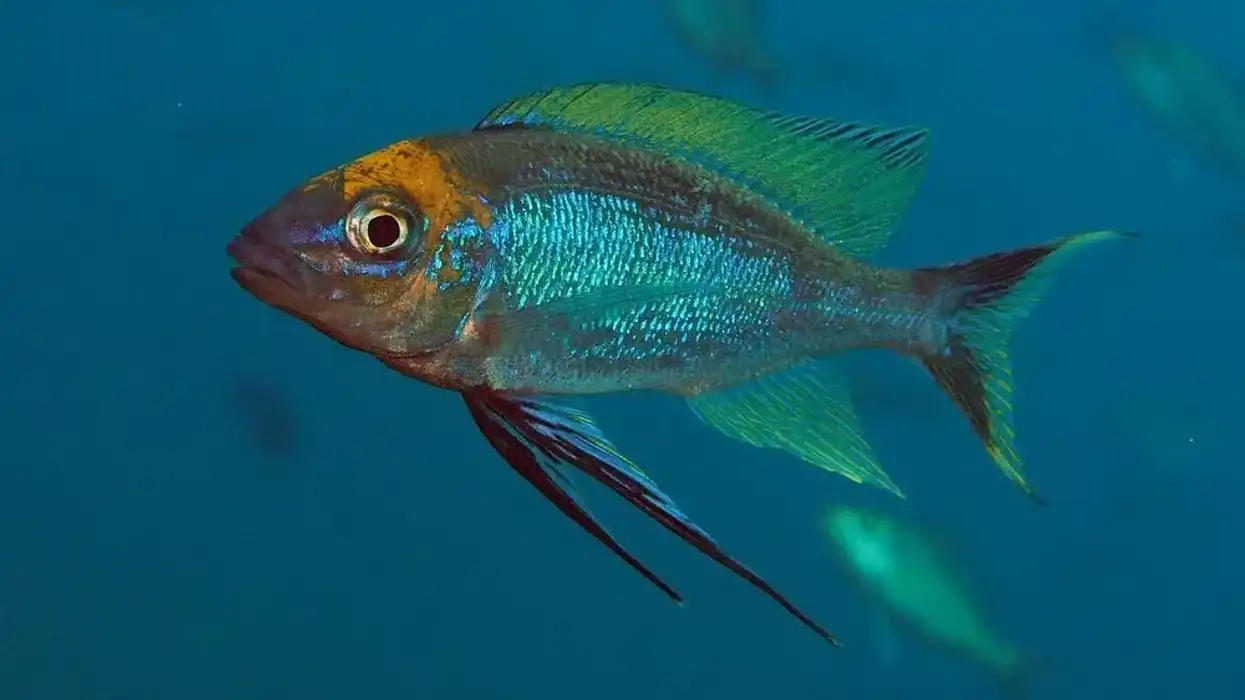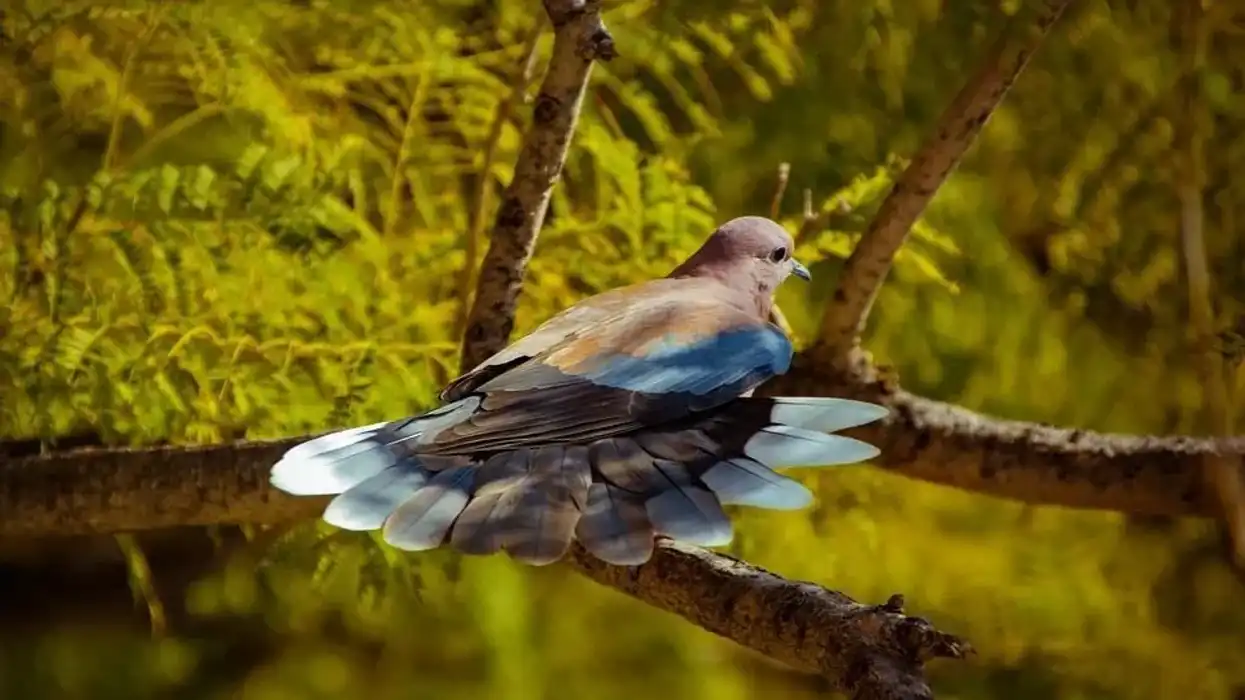The bronze featherback (Notopterus notopterus) is from the family Notopteridae and is found in the south and Southeast Asia range. It is known to be a freshwater fish and its habitat consists of swamps, tributaries, lakes, floodplains, and river basins.
The adult has a plain brown-colored body, whereas, the juveniles differ and tend to have a darker body with stripes and bars on the body. The body of this species is lengthened and flat and its back is arched.
This species gets its name because of the small dorsal fin on the back which swings just like a feather. This fish gets pale and light as it matures.
The diet of this species is omnivorous and food consists of crustaceans, invertebrates, and other small fish. It can be fed prawns, shrimps, and bloodworms but should not be fed food fish or feeder fish like livebearers and small goldfish.
It is a freshwater species but can also be found in brackish waters sometimes.
It can be kept as a pet but these species require plants and rocks in order to hide and there should be a high-quality filter in the aquarium. It is known to have a peaceful temperament comparatively but is territorial and aggressive with its own kind.
In the aquarium trade, it is also known with names like ghost knifefish and Asian knifefish and is popularly consumed in Laos, Indonesia, and Thailand, and other parts of Southeast Asia.
It is very gripping to explore this species, bronze featherback (Notopterus notopterus), and if you like, read about needlefish and lumpfish, too.
Bronze Featherback Interesting Facts
What type of animal is a bronze featherback?
The bronze featherback is a type of fish.
What class of animal does a bronze featherback belong to?
It is classified under the class of Actinopterygii of fishes.
How many bronze featherbacks are there in the world?
There is no estimation available for the total population of this fish species.
Where does a bronze featherback live?
This fish species is found in the Southeast and South Asia range. It is believed that it is one of Indonesia's endemic species and has a high commercial and economic value.
What is a bronze featherback's habitat?
The habitat of a bronze featherback (Notopterus notopterus) of the family Notopteridae consists of the bottom parts of swamps, tributaries, lakes, floodplains, and river basins. It tends to inhabit some man-made dams, too. For spawning, these fish species move to the flooded forests. It can also inhabit brackish water sometimes.
Who does bronze featherback live with?
Not much is known about these fishes living alone or in groups.
How long does a bronze featherback live?
The life expectancy of this fish is unknown.
How do they reproduce?
Not a lot is known about the reproduction of this bronze featherback (Notopterus notopterus) of the family Notopteridae, but it is believed that these fishes go to the flooded forests for spawning season and the female lays for about 1200-3000 eggs in submerged vegetation but the exact breeding season in the wild is not known.
In the rainy season, it breeds in running or stagnant water.
What is their conservation status?
The bronze featherback (Notopterus notopterus) is placed under the Least Concern category of conservation status.
Bronze Featherback Fun Facts
What does bronze featherback look like?
The adults of the bronze featherback (Notopterus notopterus) are known to be simple brown in color, whereas, the young ones are known to have dark-colored stripes all over the body. The body is known to be elongated and flat and it tends to have an arched back.
It is known to have a joined caudal and anal fins on the underside that forms a continuous one.
This species has a dorsal fin on its back which is small and is also considered to be the reason behind the name of this fish as this fin stands upright and swings back and forth similar to a feather when it is in wind.
This fish is known to get light and pale with age. To spot it, look for the brown color and flat body.

We've been unable to source an image of a bronze featherback and have used an image of its habitat. If you are able to provide us with a royalty-free image of a bronze featherback, we would be happy to credit you. Please contact us at hello@kidadl.com.
How cute are they?
These fish are not considered cute by people.
How do they communicate?
Fishes, in general, tend to communicate through visual, chemical, and tactile cues.
How big is a bronze featherback?
These fish are around 24 in (60 cm) long. It is slightly larger than a fluke fish and a drum fish.
How fast can a bronze featherback swim?
The swimming speed of this fish is unknown. This fish is considered to be a graceful swimmer.
How much does a bronze featherback weigh?
The weight of this fish is not known.
What are the male and female names of the species?
Males and females of this species do not have any particular name.
What would you call a baby bronze featherback?
Baby fish are in general referred to as young ones or juveniles and babies of this species do not have any specific names.
What do they eat?
The diet of this fish is known to be omnivorous and the food of this fish consists of crustaceans, small fish, and invertebrates. This fish also feeds on vegetation sometimes.
In captivity, it can be fed small earthworms, bloodworms and adults can be fed prawns and shrimps, too. In the wild, this species feeds after the sun sets and continues through the night.
When feeding this fish, it should be kept in mind that this fish should not be given avian or mammalian meat like chicken or beef heart as these contain certain lipids that cannot be metabolized by this fish and lead to the excess deposit of fat and also organ degeneration.
Also, feeder fishes like small goldfish and livebearers should be avoided as they carry a risk of parasites or diseases unless conditioned properly.
Are they dangerous?
These fish are not considered dangerous.
Would they make a good pet?
Not especially as these fish are usually for consumption purposes
Did you know...
The bronze featherback (Notopterus notopterus) of the family Notopteridae, in the aquarium trade, is also known as the ghost knifefish or Asian knifefish.
This fish is known to be on the Kingdom of Laos stamp.
This fish species is quite popular as food and is consumed in Southeast Asia since ancient times. In Thailand, Laos, and Indonesia especially, the bronze featherback (Notopterus notopterus) is considered an important food item.
Notopterus is derived from ancient Greek, 'noton' means 'back' and 'pteron' refers to 'wing feather' in the context of a fin that is small and like a quill.
These fish might often be confused with an African knifefish, although both the species can be differentiated based on the smaller size and absence of dorsal fin in the African knifefish.
The bronze featherback (Notopterus notopterus) is a species of complex fish.
Does the bronze featherback enter brackish waters?
This fish is generally considered to be a freshwater species, but it has been recorded that this fish can enter brackish waters, too.
How many eggs does a bronze featherback lay?
The female of the bronze featherback (Notopterus notopterus) lays around 1200-3000 eggs.
Here at Kidadl, we have carefully created lots of interesting family-friendly animal facts for everyone to discover! Learn more about some other fish from our cherry barb facts and foxface rabbitfish facts pages.
You can even occupy yourself at home by coloring in one of our free printable fish mosaic coloring pages.










